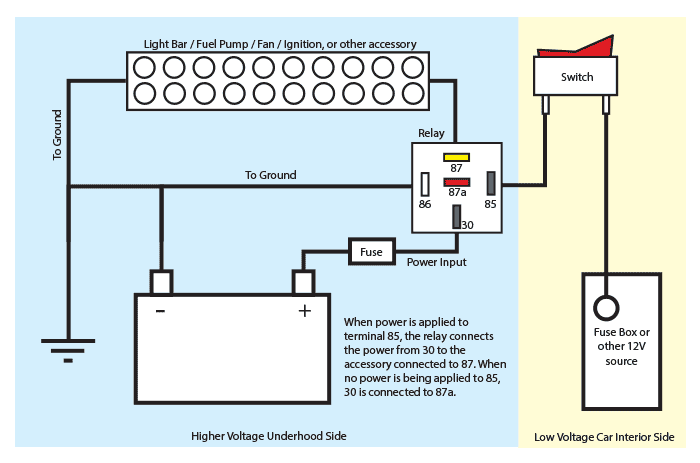Using Relays in Automotive Wiring
Relays are a mechanical device that can connect or disconnect power to an accessory when it gets a low voltage ‘signal’ from a switch. Some people may ask why they should bother using a relay when you can just wire an accessory directly through a switch to its power source. There are two main reasons why relays are utilized:
- Using a relay keeps the higher voltage out of the passenger compartment of the vehicle and is just less taxing on your vehicle’s electrical system in general. If something were to fail and short, the chances of an interior fire are significantly reduced if a relay is utilized to allow the higher voltage switching occur in the engine compartment. This also reduces the load on the interior fuse panel by placing a smaller demand on it.
- It allows the use of less heavy gauge wire. The longer the wire, the higher the resistance. By using a relay near the item being switched, you use less of the heavier gauge wire.
Some may argue that relays add an additional failure point to an electrical system. Although relays do eventually wear out after repeated use, the potential for failure can be reduced if they are replaced periodically, or you could wire two relays in parallel. If wired in parallel, one relay can fail and the other can continue to operate. This technique is commonly used in cooling fans.
Consider a typical user upgrade – adding fog lamps to the front of a vehicle. Many would tap into power at the fuse block, run it to a dash mounted switch, then back through the firewall all the way forward to the lights. Wiring with a relay allows the power to run straight from the battery, through the relay mounted nearby, directly to the lights. The interior mounted switch only draws minimal power though the interior fuse block to activate the relay.
Buy Relays, Pigtails, and Kits HERE
See below for an example of how to wire an accessory using a relay. The color coding on the relay matches our relay harness pigtail.
